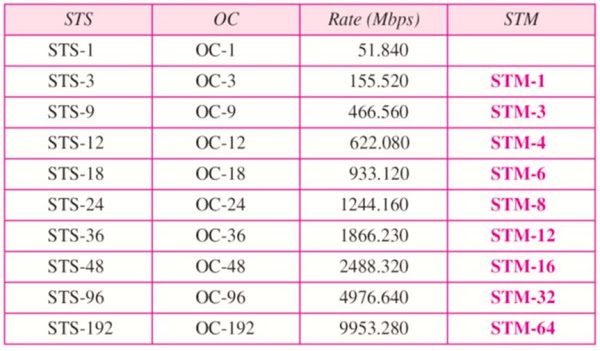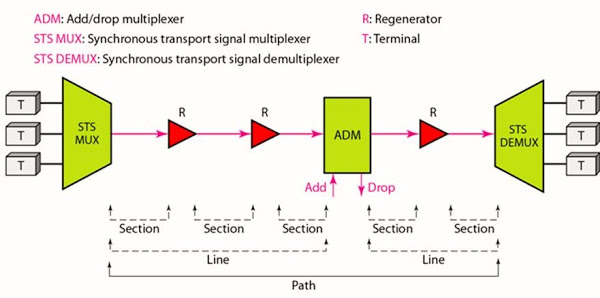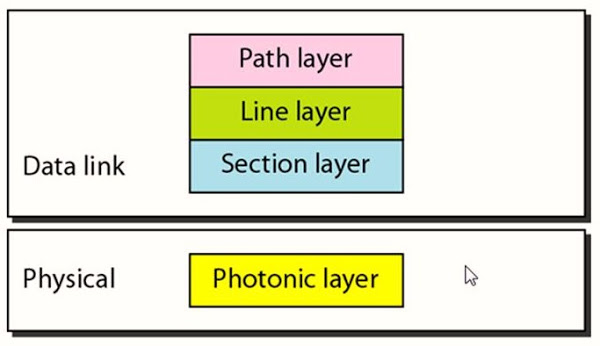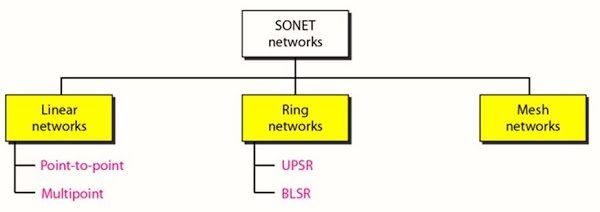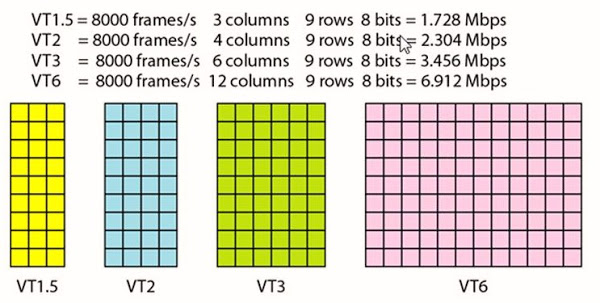Definition of Terms
- Synchronous Optical Network (SONET) is a standard developed by ANSI for fiber-optic networks: Synchronous Digital Hierarchy (SDH) is a similar standard developed by ITU-T.
- SONET was developed by ANSI; SDH was developed by ITU-T.
- Each synchronous transfer signal STS-n is composed of 8000 frames. Each frame is a two-dimensional matrix of bytes with 9 rows by 90 × n columns.
- A SONET STS-n signal is transmitted at 8000 frames per second.
- Each byte in a SONET frame can carry a digitized voice channel.
- In SONET, the data rate of an STS-n signal is n times the data rate of an STS-1 signal.
- STS multiplexers/demultiplexers mark the beginning points and endpoints of a SONET link.
- An STS multiplexer multiplexes signals from multiple electrical sources and creates the corresponding optical signal.
- An STS demultiplexer demultiplexes an optical signal into corresponding electric signals.
- Add/drop multiplexers allow insertion and extraction of signals in an STS. An add/drop multiplexer can add an electrical signals into a given path or can remove a desired signal from a path.
- SONET has defined a hierarchy of signals called synchronous transport signals (STSs). SDH has defined a similar hierarchy of signals callefd synchronous transfer modules (STMs).
- An OC-n signal is the optical modulation of an STS-n (or STM-n) signal.
- Pointers are used to show the offset of the SPE in the frame or for justification.
- SONET uses two pointers show the position of an SPE with respect to an STS.
- SONET use the third pointer for rate adjustment between SPE and STS.
- A regenerator takes a received optical signal and regenerates it.
- The SONET regenerator also replaces some of the existing overhead information with new information.
- SONET defines four layers: path, line, section, and photonic.
- The path layer is responsible for the movement of a signal from its source to its destination.
- The line layer is responsible for the movement of a signal across a physical line.
- The section layer is responsible for the movement of a signal across a physical section.
- The photonic layer corresponds to the physical layer of the OSI model. It includes physical specifications for the optical fiber channel.
- SONET uses NRZ encoding with the presence of light representing 1 and the absence of light representing 0.
- SONET is a synchronous TDM system in which all clocks are locked to a master clock.
- SONET sends 8000 frames per second; each frame lasts 125 µs.
- Section overhead is recalculated for each SONET device (regenerators and multiplexers).
- Path overhead is only calculated for end-to-end (at STS multiplexers).
- An STS-3c signal can carry 44 ATM cells as its SPE.
- An STS-I frame is made of 9 rows and 90 columns; an STS-n frame is made of 9 rows and n x 90 columns.
- STSs can be multiplexed to get a new STS with a higher data rate.
- SONET network topologies can be linear, ring, or mesh.
- A linear SONET network can be either point-to-point or multipoint.
- A ring SONET network can be unidirectional or bidirectional.
- To make SONET backward-compatible with the current hierarchy, its frame design includes a system of virtual tributaries (VTs).
- SONET is designed to carry broadband payloads. Current digital hierarchy data rates, however, are lower than STS-1. To make SONET backward-compatible with the current hierarchy, its frame design includes a system of virtual tributaries (VTs). A virtual tributary is a partial payload that can be inserted into an STS-1.
A SONET system can use the following equipment:
- 1. STS multiplexers
- 2. STS demultiplexers
- 3. Regenerators
- 4. Add/drop multiplexers
- 5. Terminals
SONET/SDH rates
A simple network using SONET equipment
SONET layers compared with OSI or the Internet layers
Taxonomy of SONET networks
Virtual tributary types
Note: You can proceed to take the multiple choice exam regarding this topic. SONET/SDH – Set 1 MCQs
List of Data Communications Lectures
credit: Behrouz A. Forouzan©2013 www.PinoyBIX.org
Please do Subscribe on YouTube!
P inoyBIX educates thousands of reviewers and students a day in preparation for their board examinations. Also provides professionals with materials for their lectures and practice exams. Help me go forward with the same spirit.
“Will you subscribe today via YOUTUBE?”
What You Also Get: FREE ACCESS & DOWNLOAD via GDRIVE
TIRED OF ADS?
- Become Premium Member and experienced fewer ads to ads-free browsing.
- Full Content Access Exclusive to Premium members
- Access to PINOYBIX FREEBIES folder
- Download Reviewers and Learning Materials Free
- Download Content: You can see download/print button at the bottom of each post.
PINOYBIX FREEBIES FOR PREMIUM MEMBERSHIP:
- CIVIL ENGINEERING REVIEWER
- CIVIL SERVICE EXAM REVIEWER
- CRIMINOLOGY REVIEWER
- ELECTRONICS ENGINEERING REVIEWER (ECE/ECT)
- ELECTRICAL ENGINEERING & RME REVIEWER
- FIRE OFFICER EXAMINATION REVIEWER
- LET REVIEWER
- MASTER PLUMBER REVIEWER
- MECHANICAL ENGINEERING REVIEWER
- NAPOLCOM REVIEWER
- Additional upload reviewers and learning materials are also FREE
FOR A LIMITED TIME
If you subscribe for PREMIUM today!
You will receive an additional 1 month of Premium Membership FREE.
For Bronze Membership an additional 2 months of Premium Membership FREE.
For Silver Membership an additional 3 months of Premium Membership FREE.
For Gold Membership an additional 5 months of Premium Membership FREE.
Join the PinoyBIX community.
This offer has expired!


